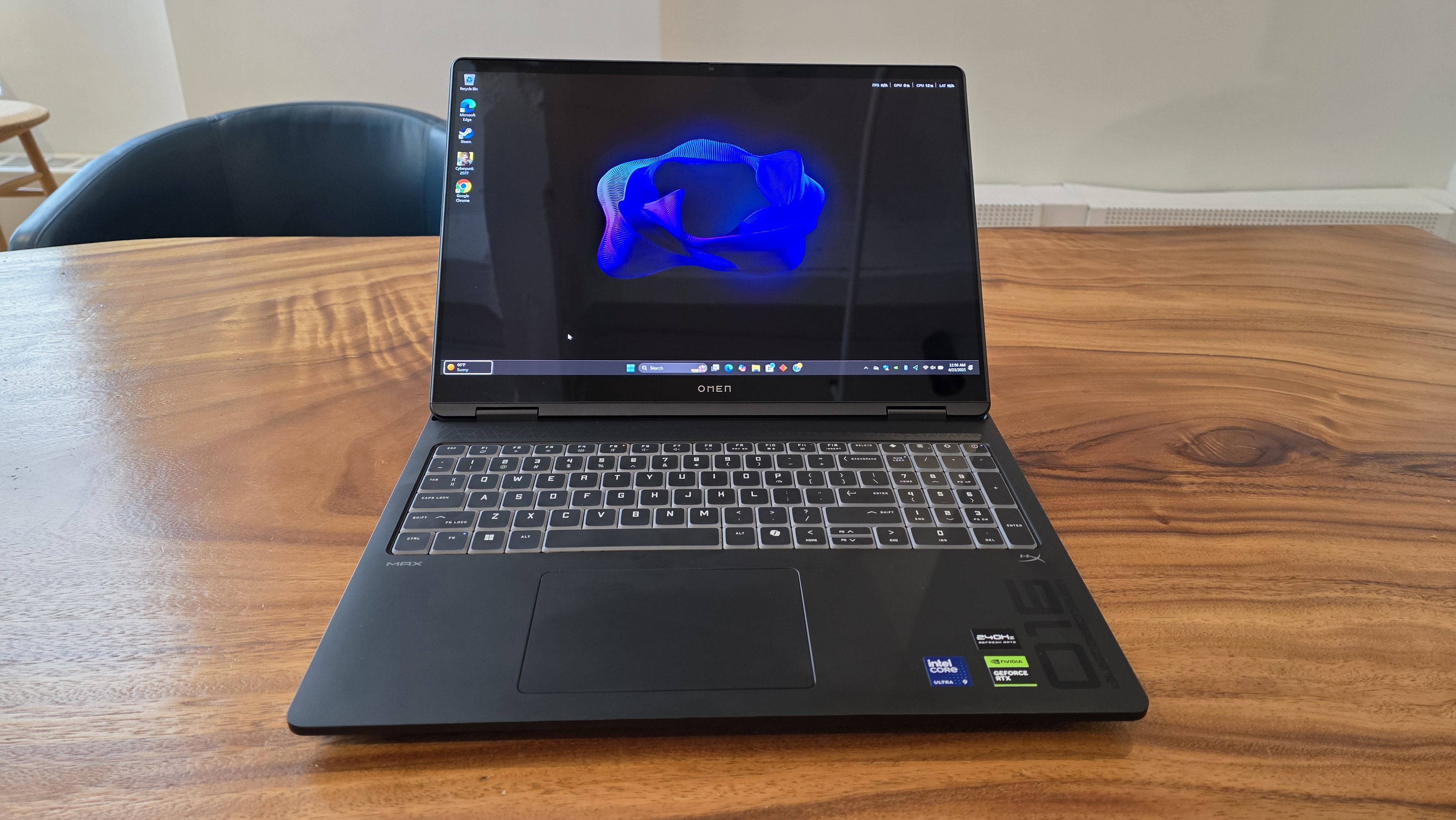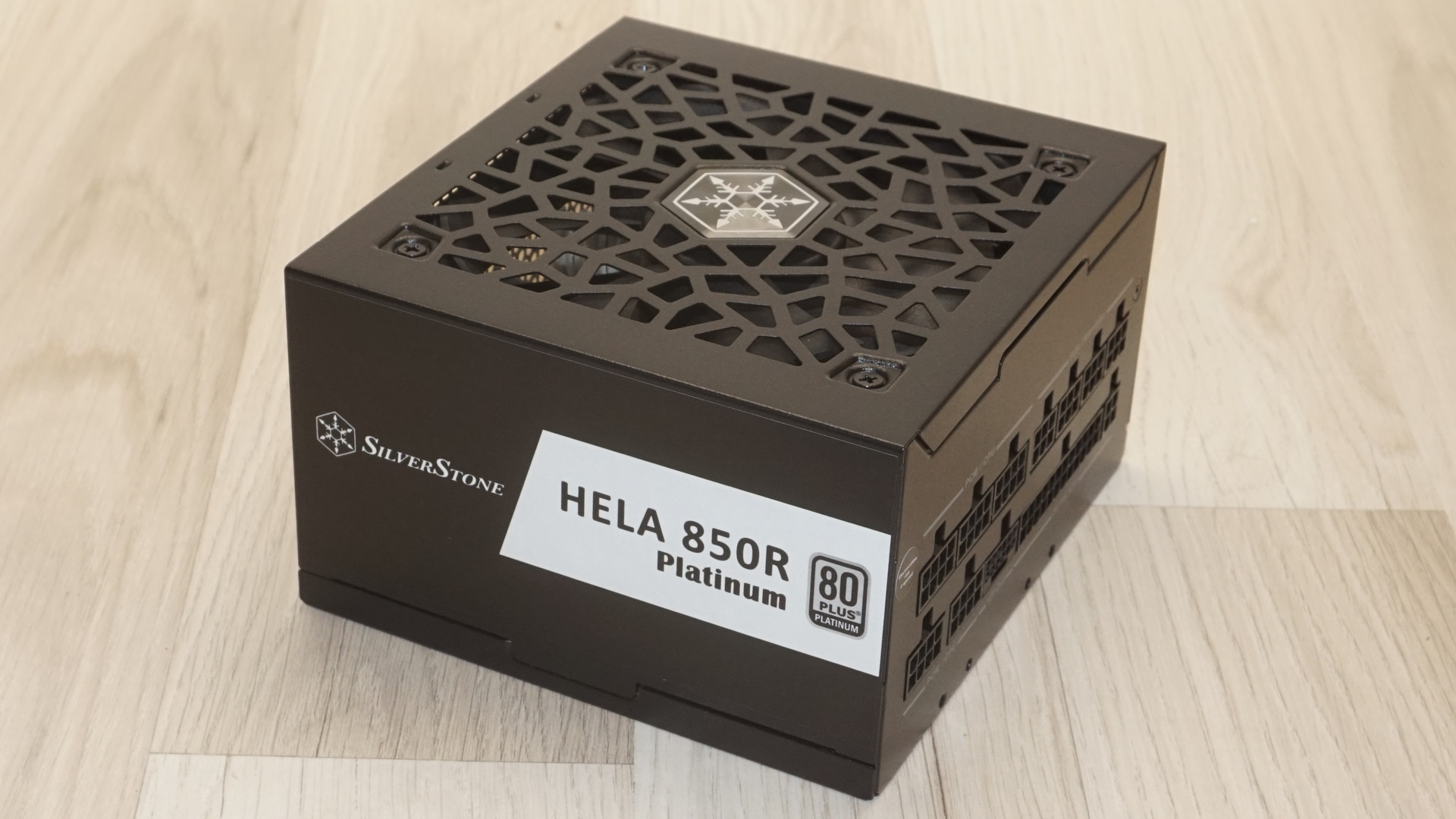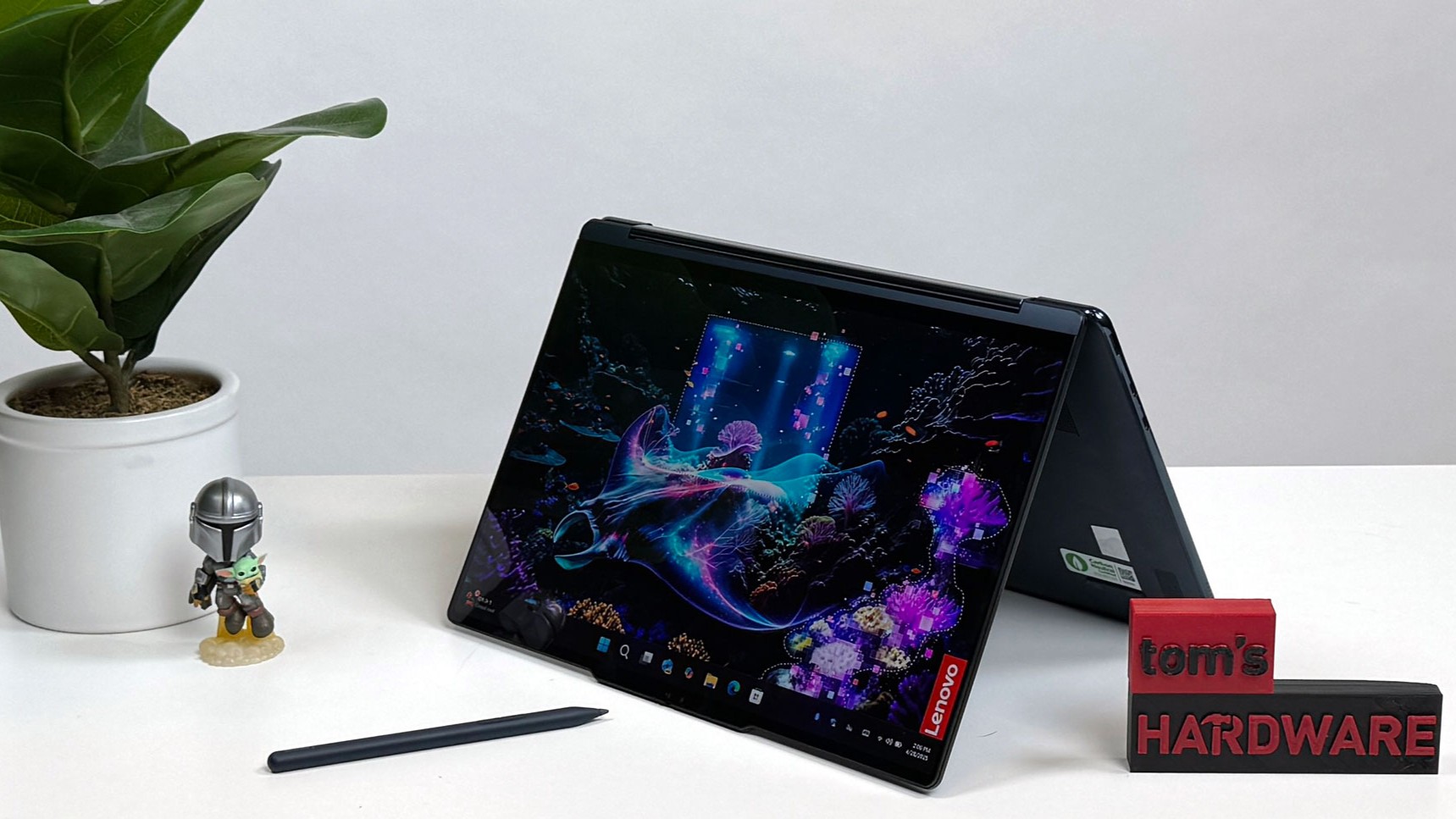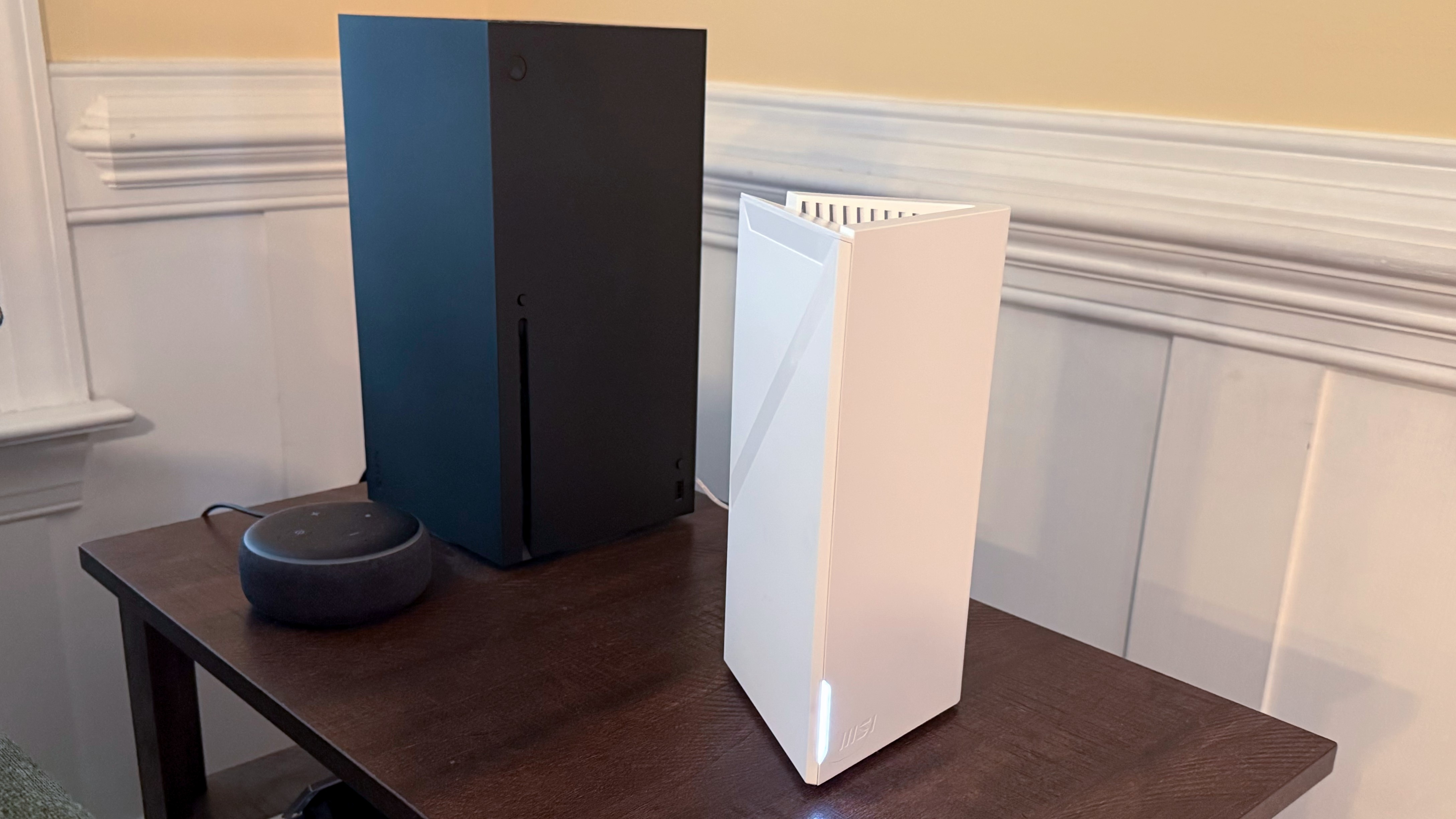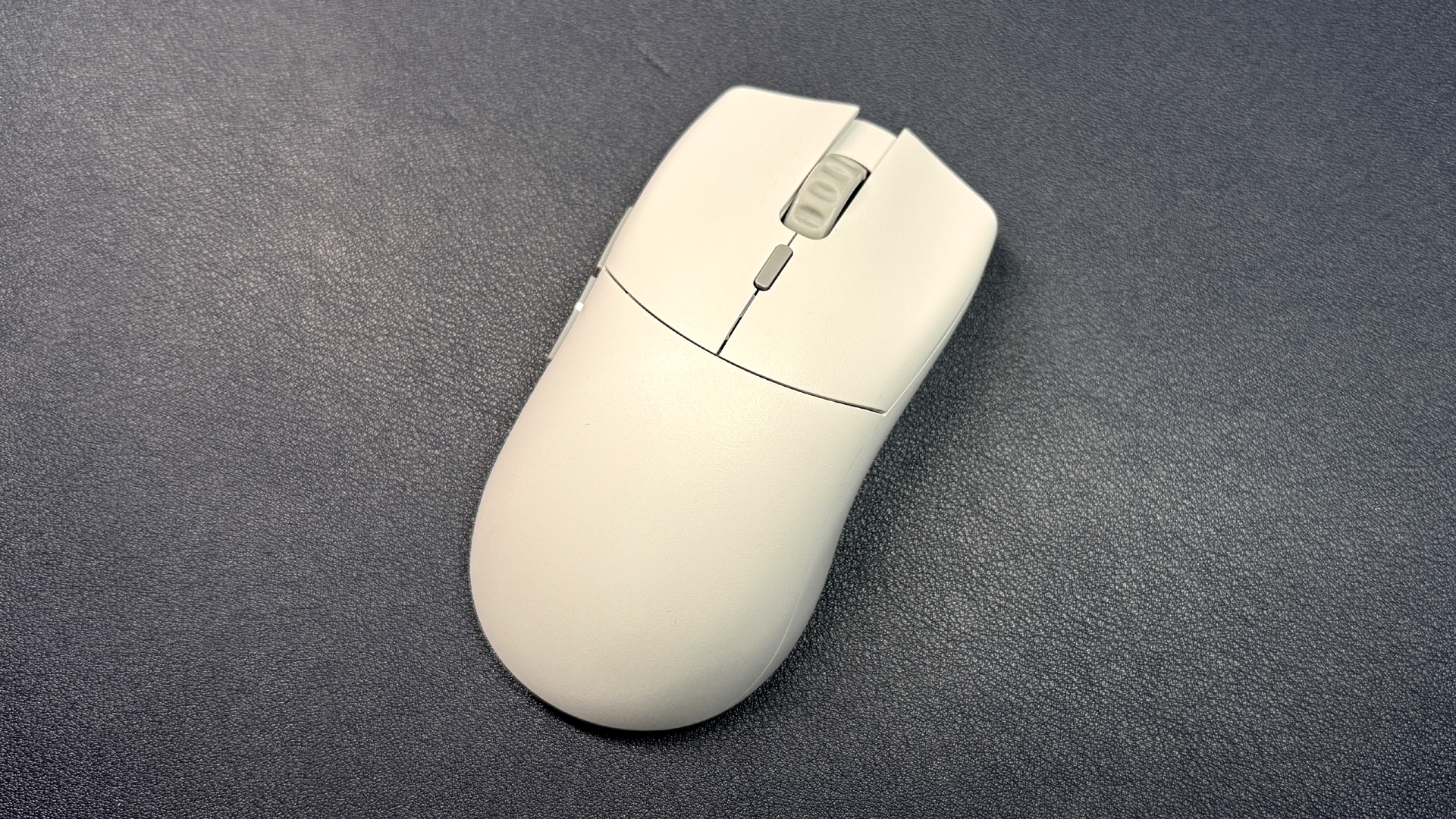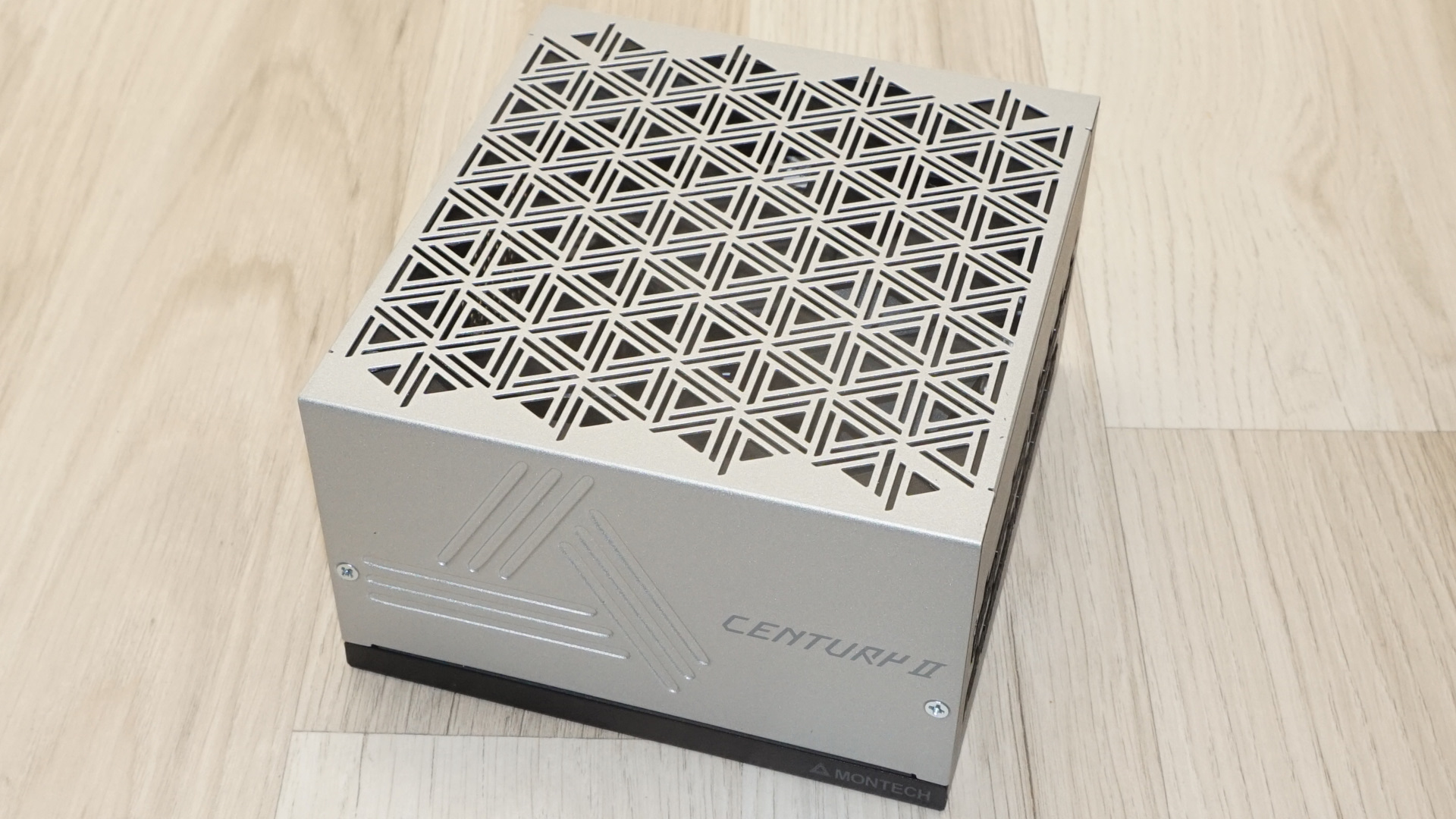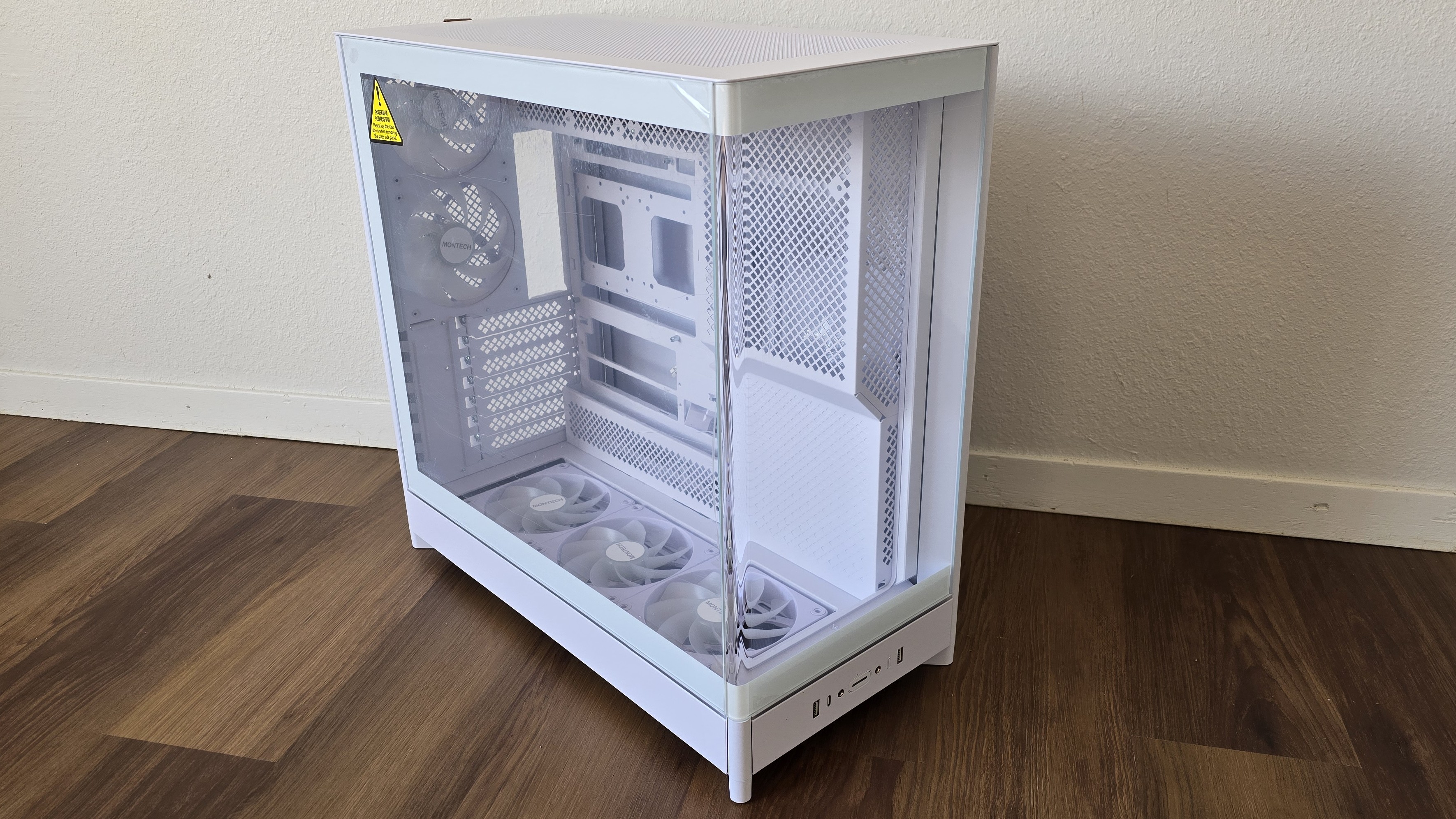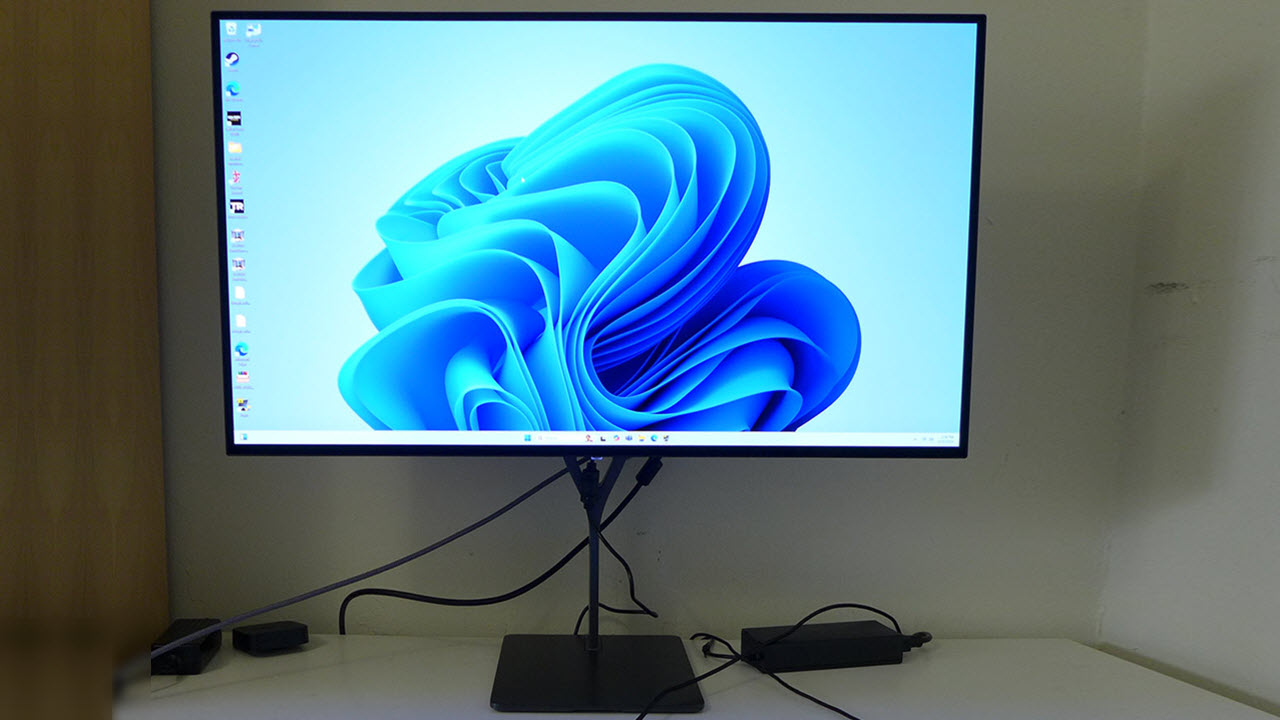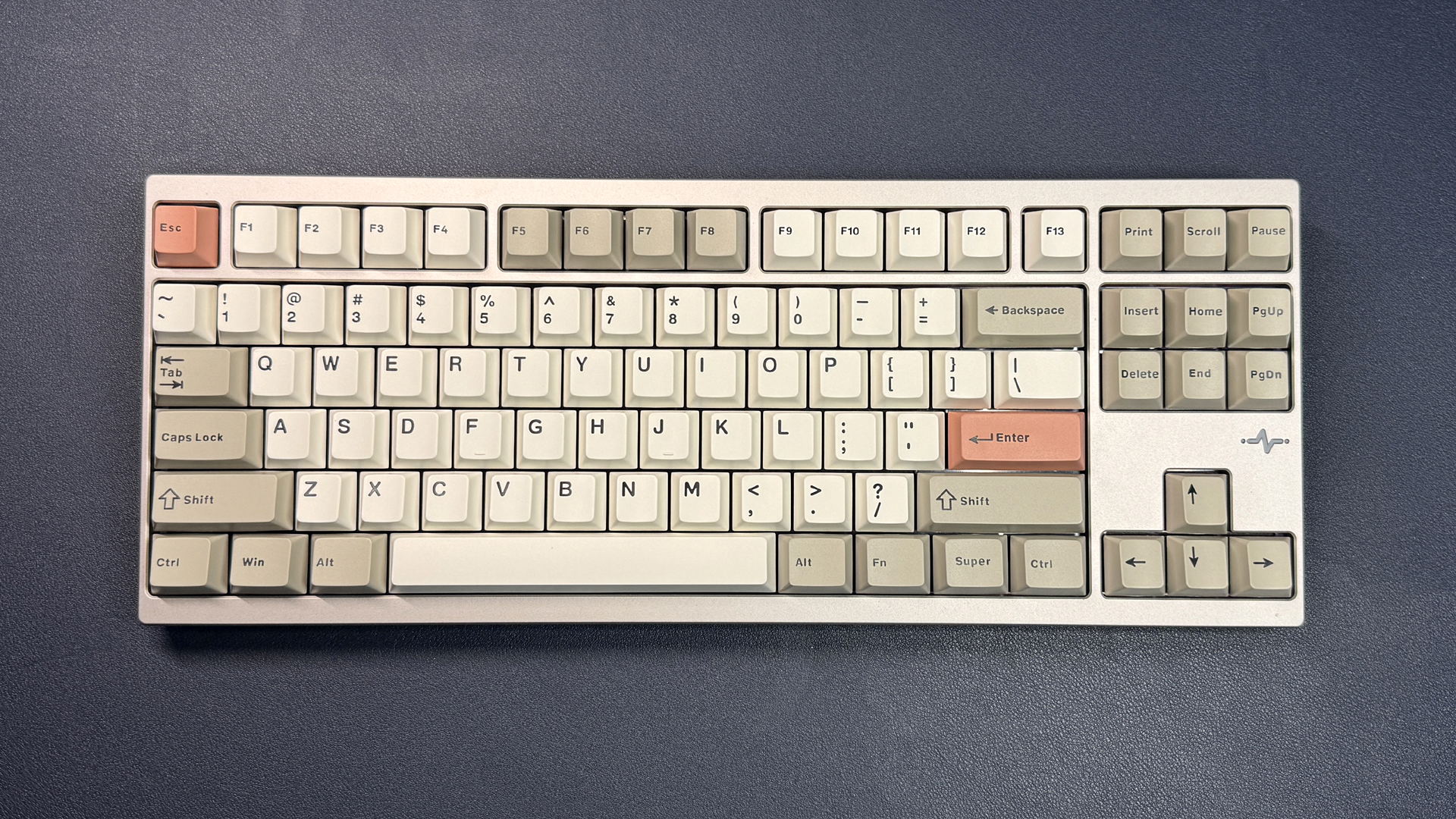MSI X299 Gaming Pro Carbon AC Motherboard Review
Why you can trust Tom's Hardware
Benchmarks & Conclusion
When paired with the directly-competing Core i9-7900X, the new motherboards slightly outperform the old X99 platform across 3DMark and PCMark. Although it's far less-expensive, the Core i7-7800X can’t stand up to the might of a 10-core CPU in 3DMark’s Physics test.
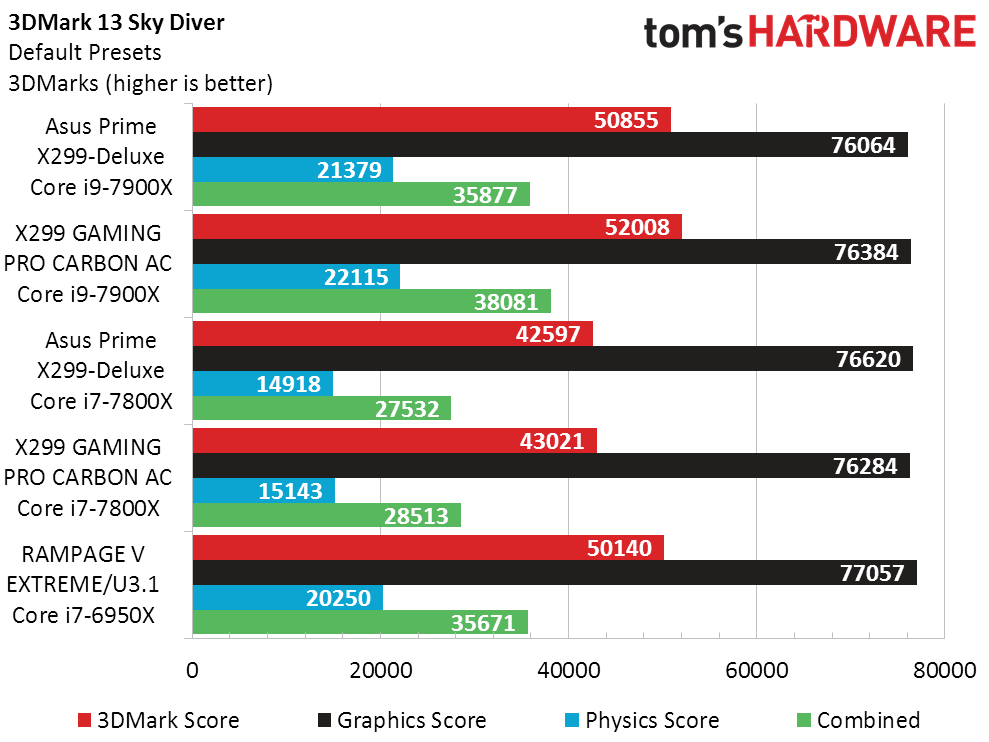
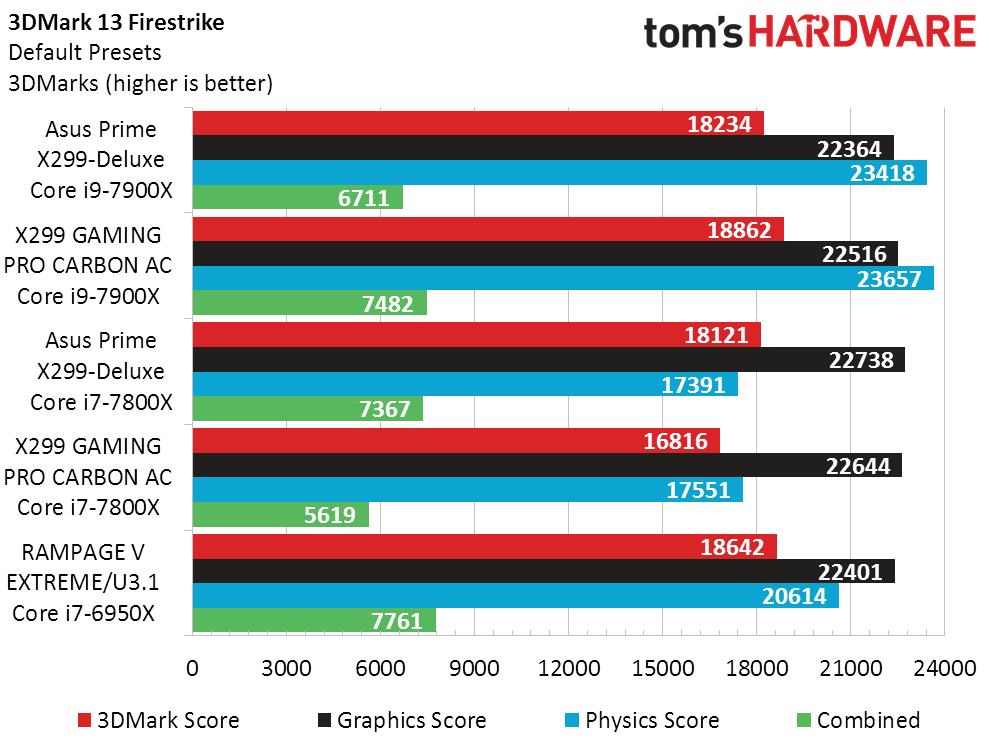

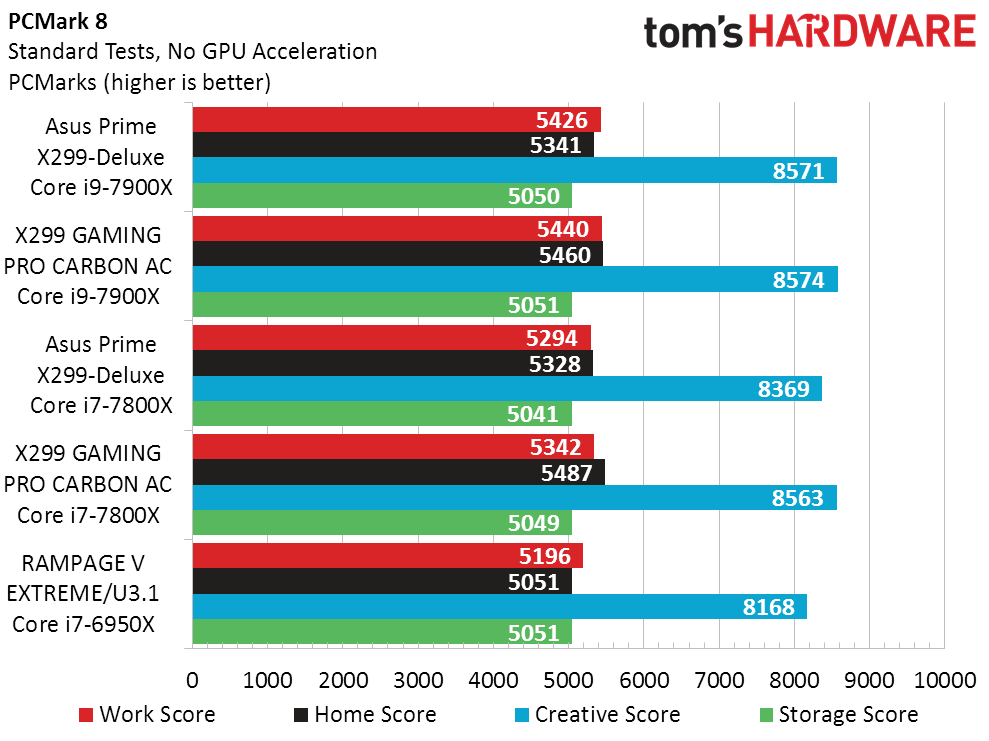
My hopes that the moderately-priced i7-7800X would compete directly against the previous generation’s expensive 10-core CPU are dashed in Sandra Arithmetic. But the Core i9-7900X beats its predecessor by an even greater amount. Better still, the boards hosting these new processors are thus far performing consistently against each other.
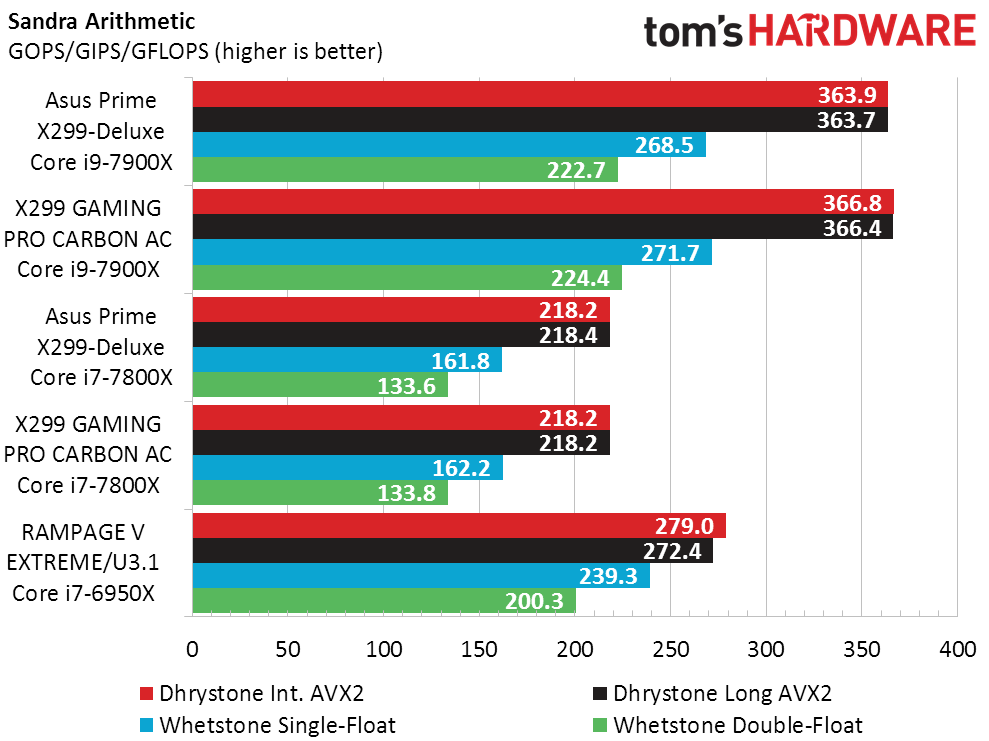
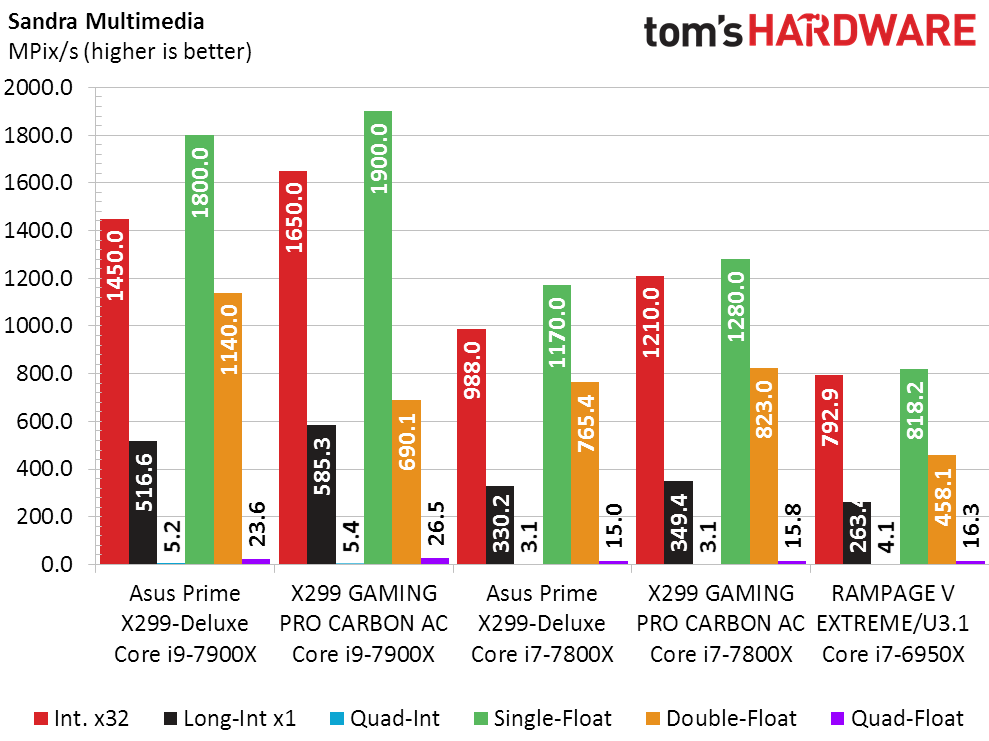

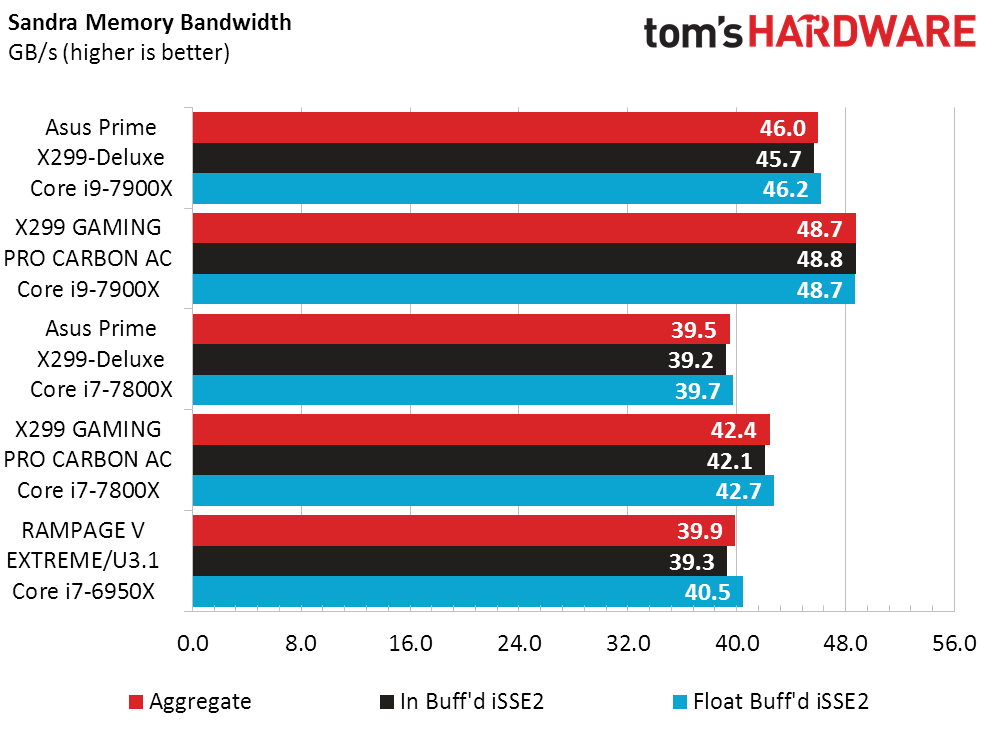
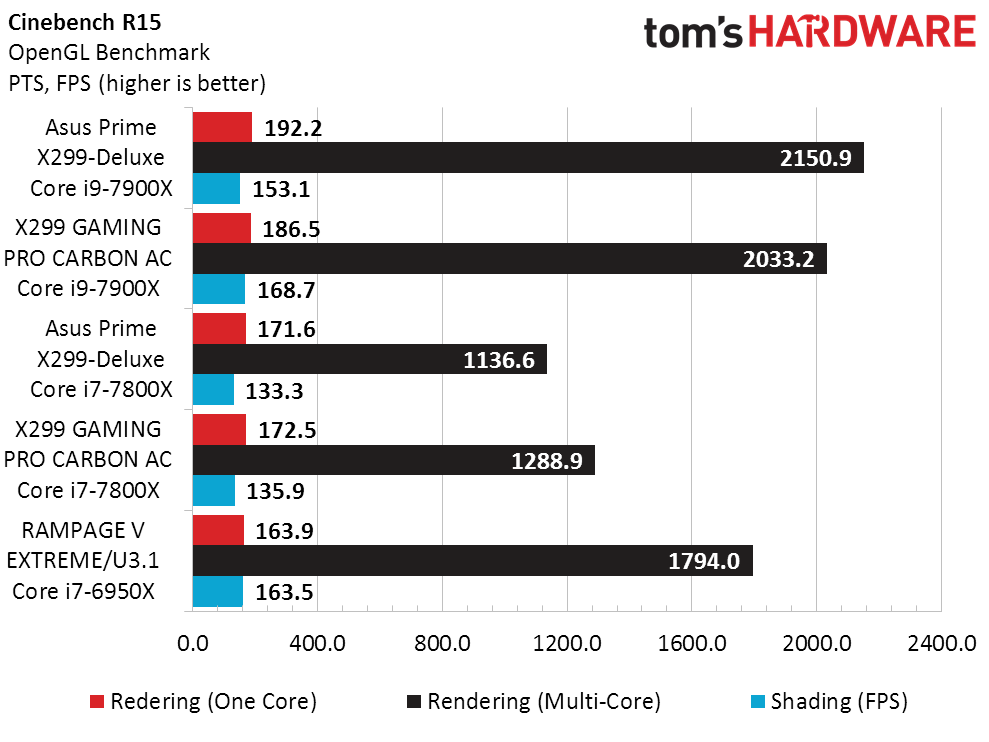
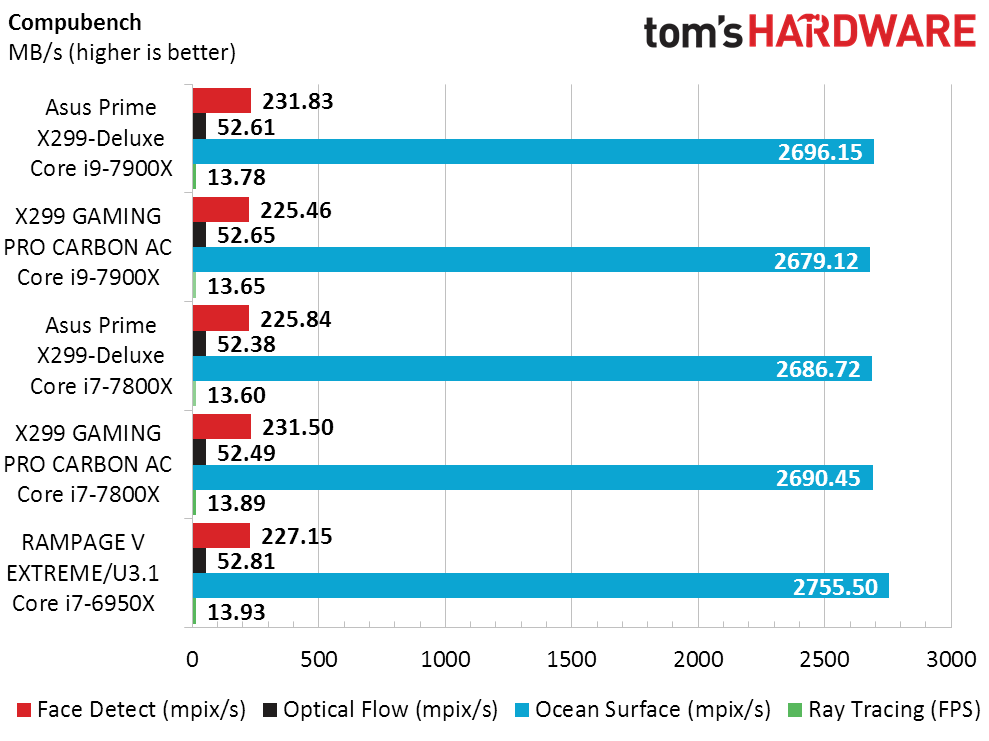
Minor inconsistencies between Asus and MSI motherboards creep in starting with Sandra Multimedia. MSI appears to have slightly more aggressive memory settings, but Asus leads Cinebench.
3D Games
The X299 Gaming Pro Carbon AC leads the Prime X299-Deluxe across Ashes, F1 2015, and Metro. We always enable each CPU's full set of power savings features and disable non-stock turbo settings to make competitions fair, as we believe that overclockers prefer to choose their own settings. Perhaps some of Intel’s green technologies aren’t fully functioning on the MSI motherboard?
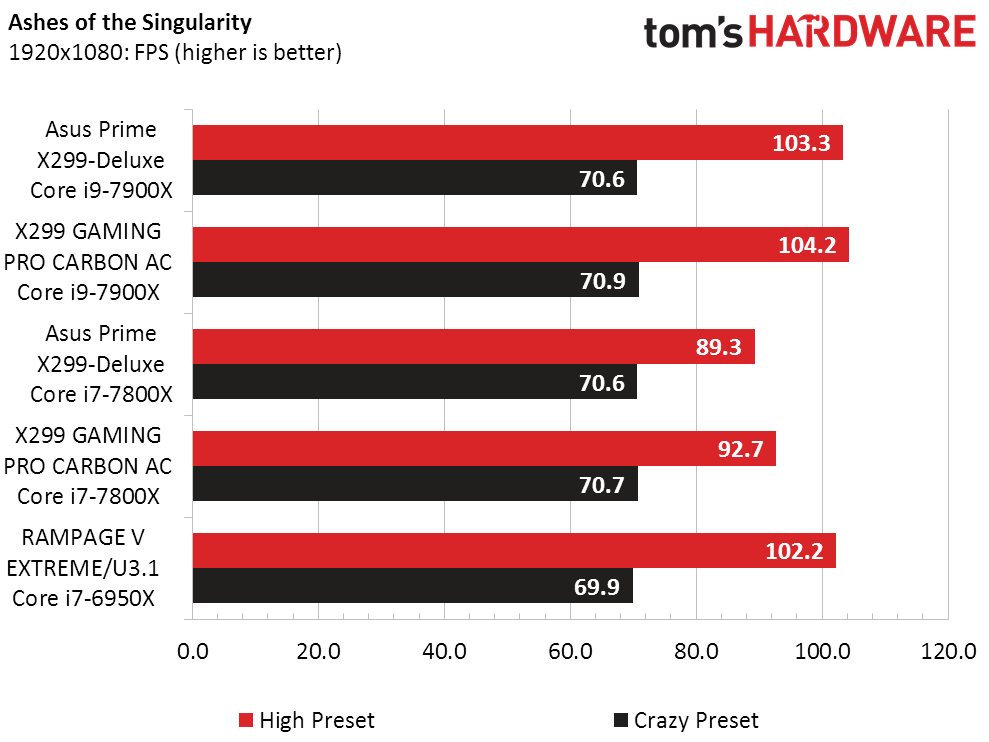
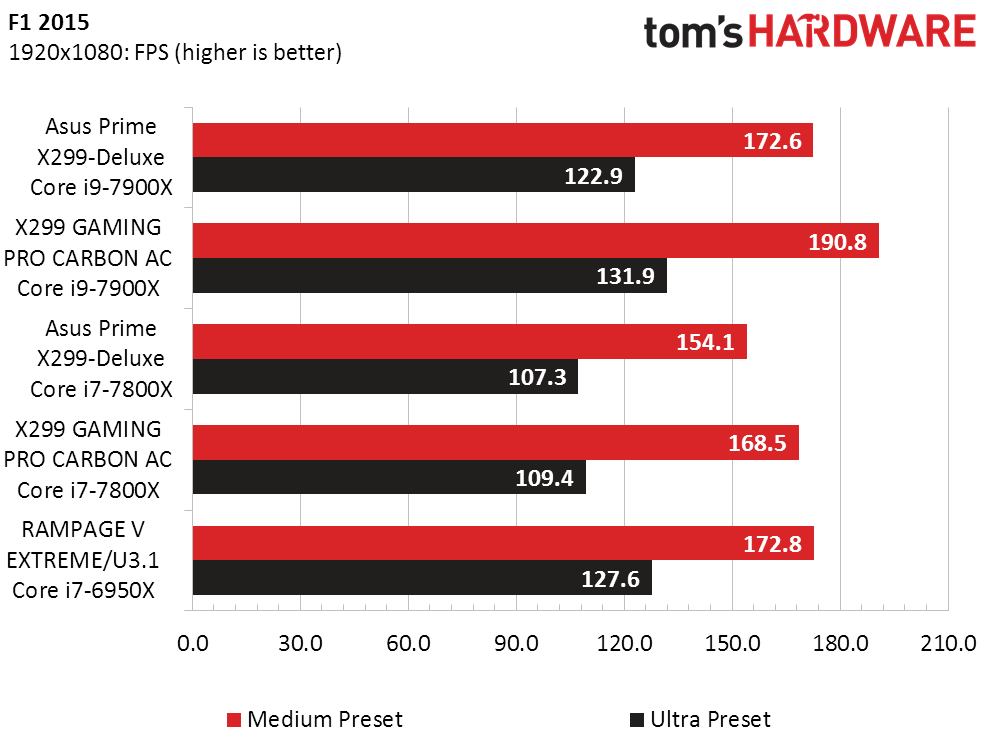
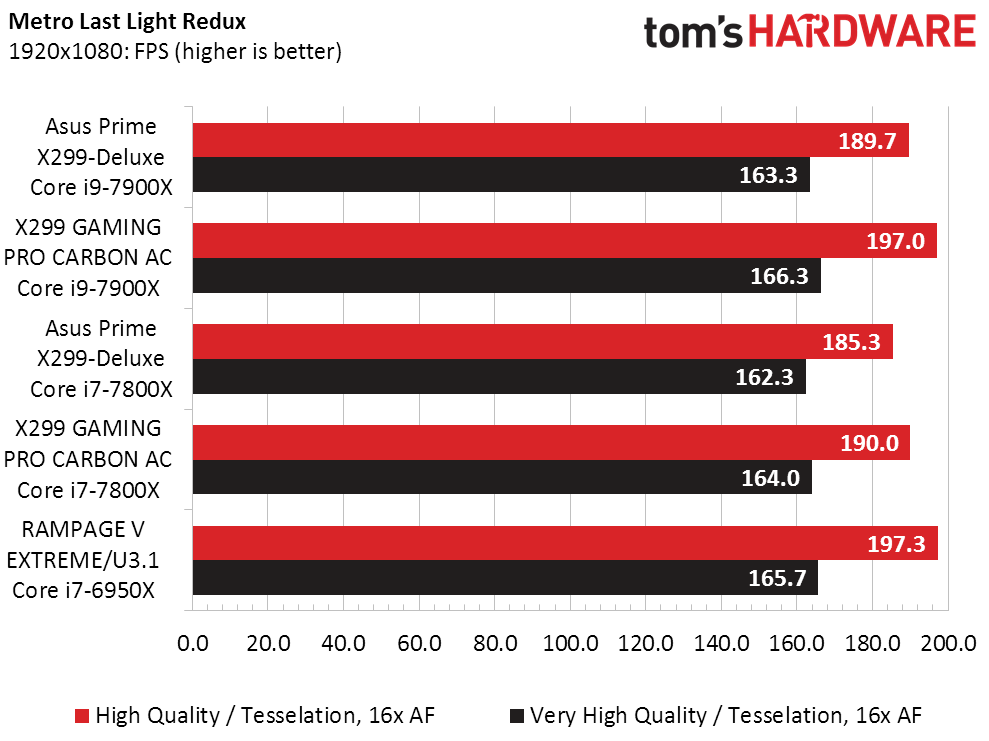
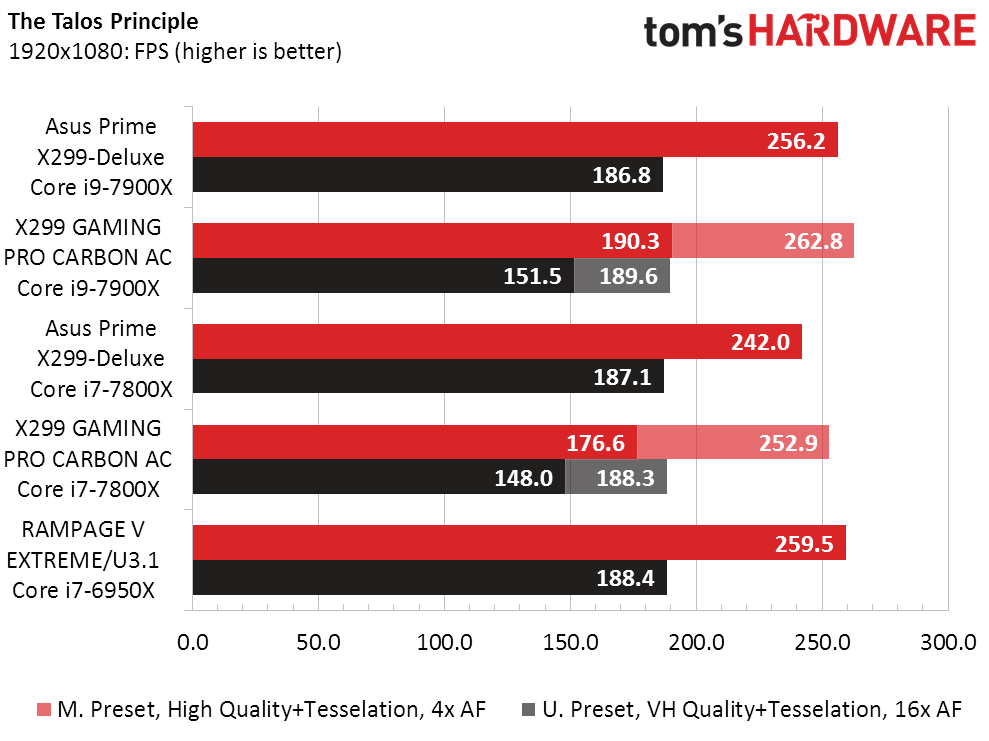
Talos kicks MSI down a notch due to the heavy load of its Nahimic software suite in this specific game. The faded bars show how the X299 Gaming Pro Carbon AC performs with Nahimic Audio Solution disabled.
Timed Applications
Less is more in timed application performance, as less encoding time means more work gets done.

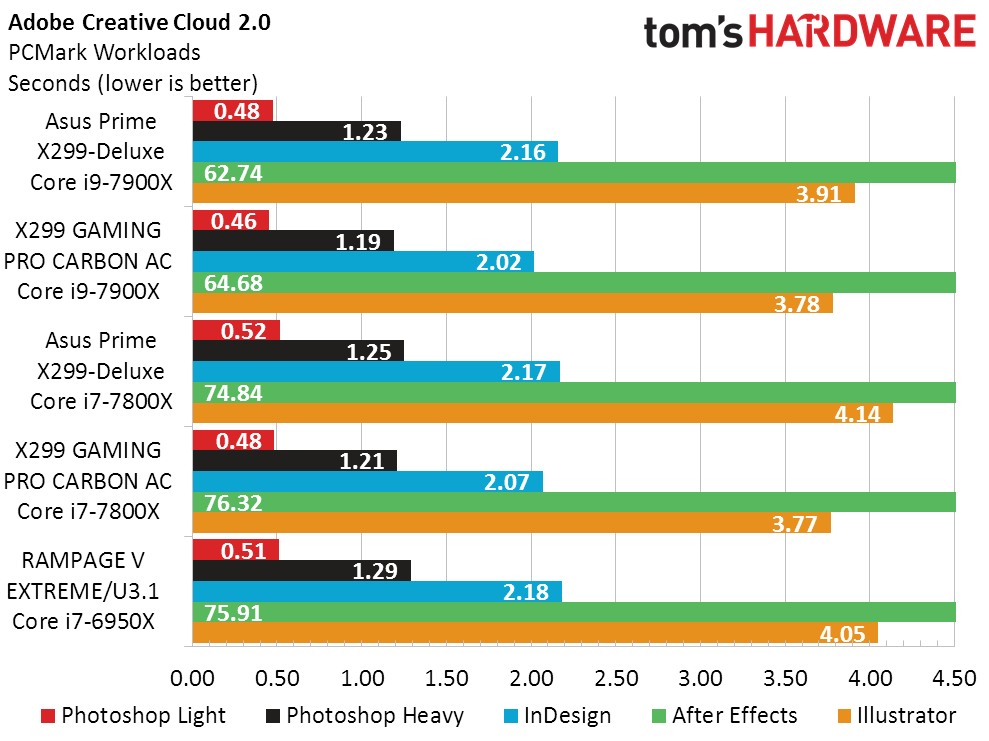
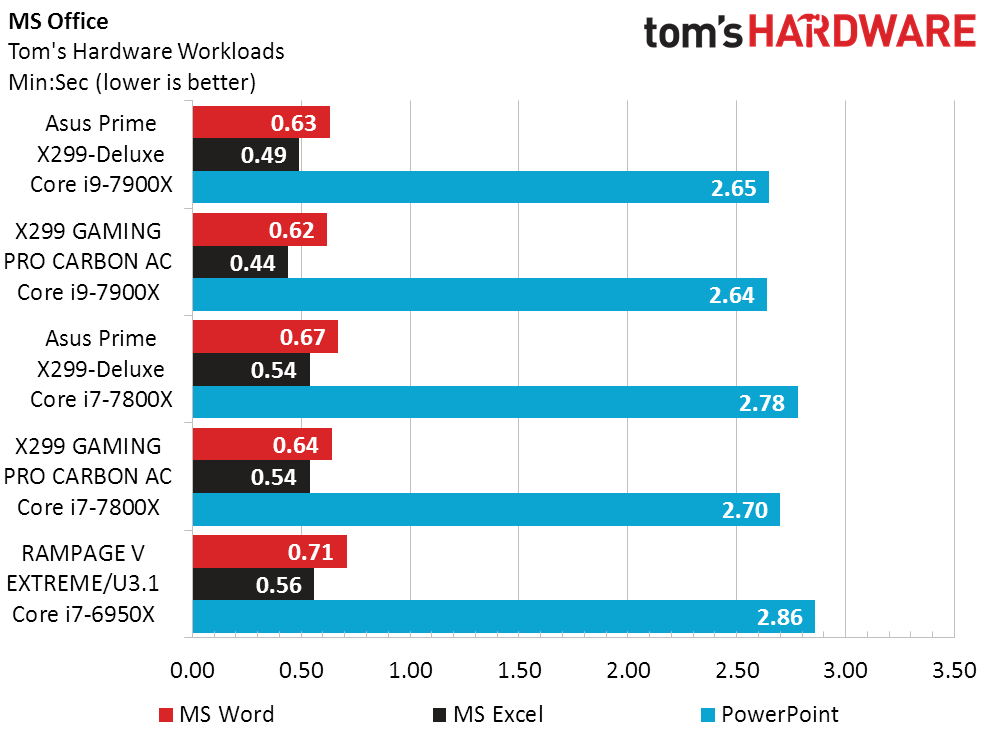
The X299 Gaming Pro Carbon leads the Prime X299-Deluxe across our mixed workload, but falls behind in Adobe After Effects.
Power, Heat & Efficiency
I had suspicions about MSI’s potential power use after seeing it win too many benchmarks to call those wins coincidental, and the power chart confirms my suspicions. Full-load heat is also significantly higher.
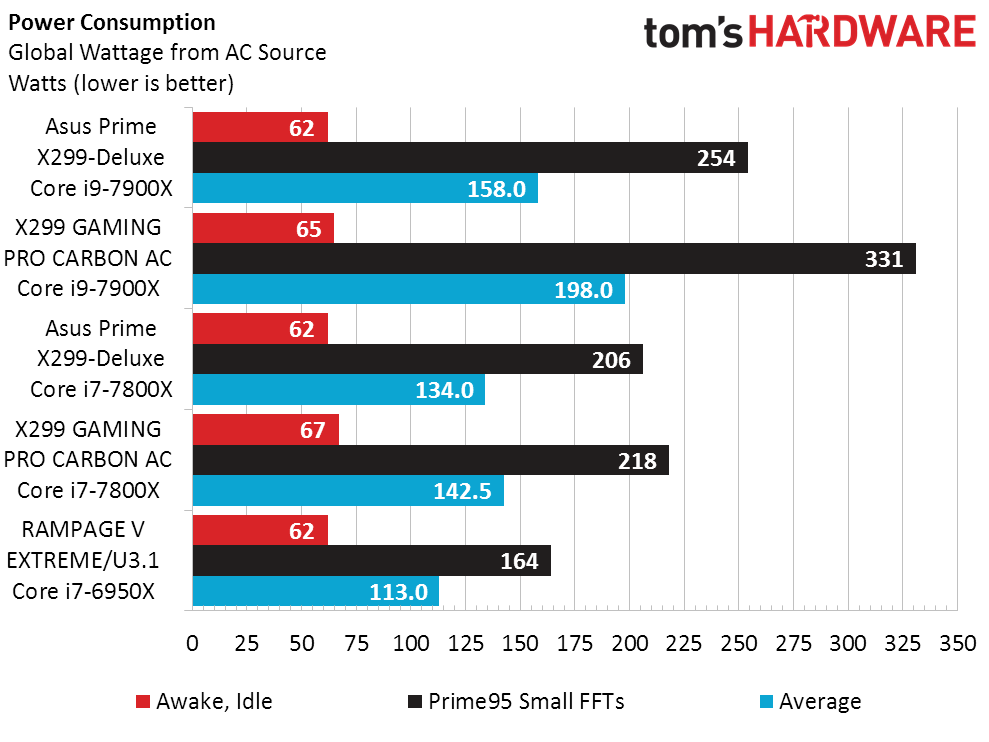
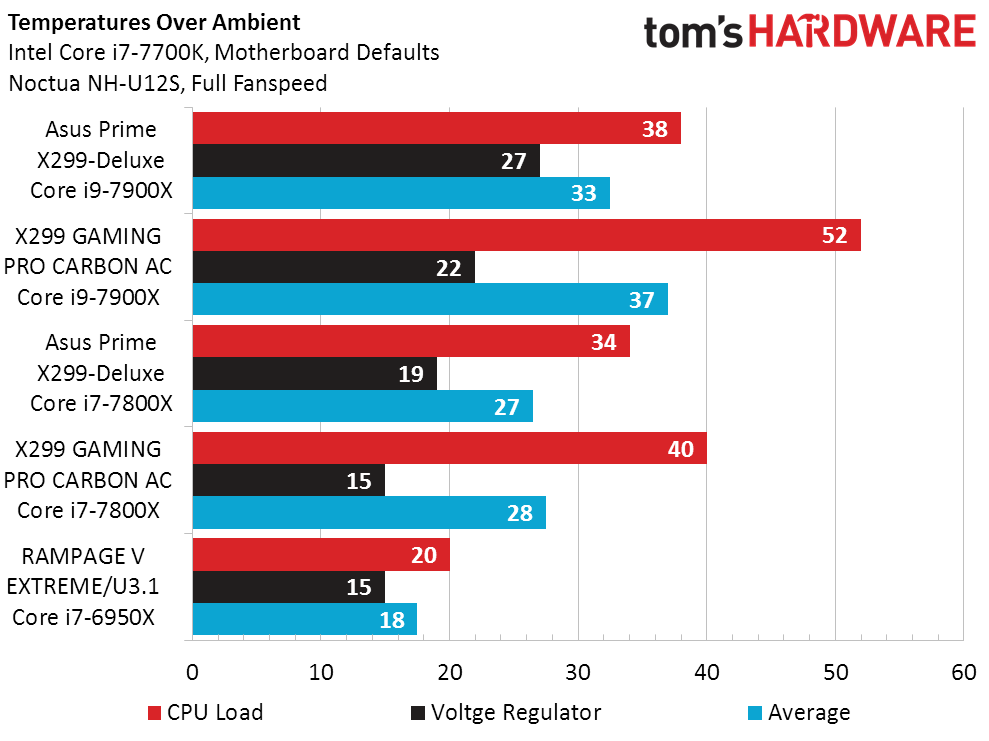
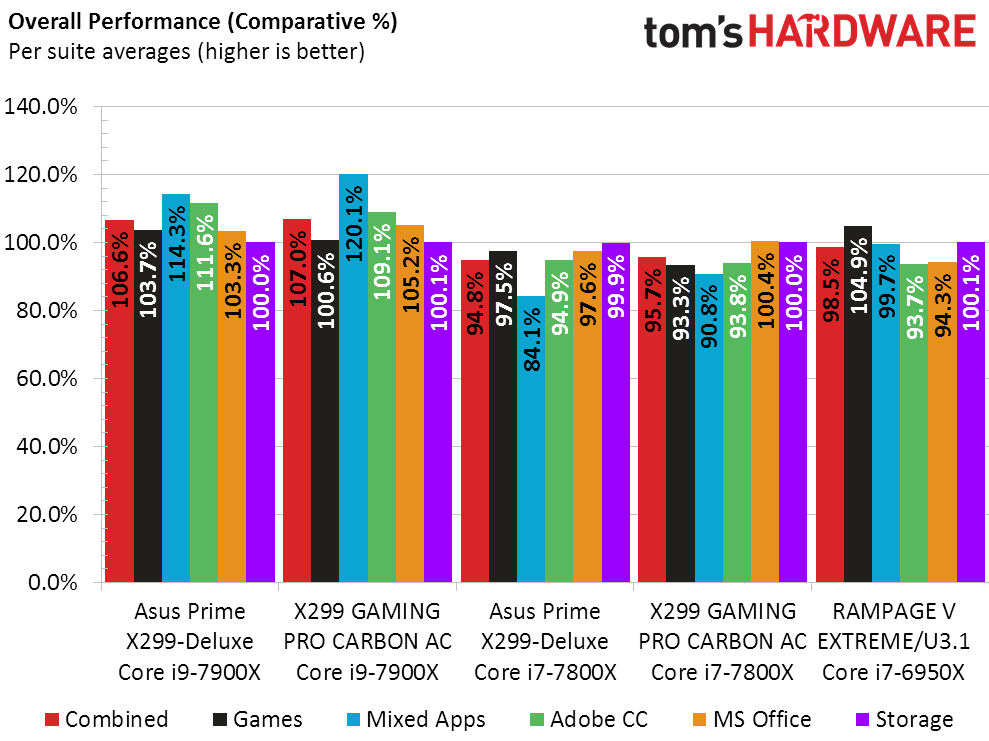
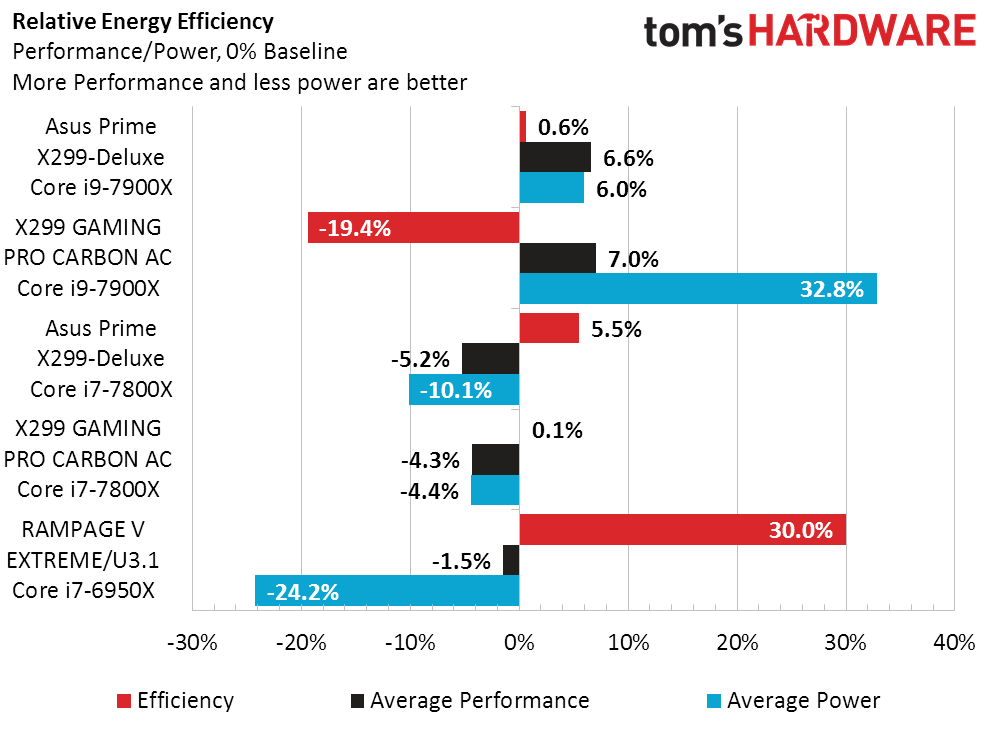
Considering the balance, the X299 Gaming Pro Carbon AC’s relatively consistent lead wasn’t large, unlike its increased power consumption. A retest may be required before comparing it to any future competitors.
Overclocking
While the Prime X299-Deluxe beats the X299 Gaming Pro Carbon AC at overclocking either processor, the reason for stopping is different. While the Prime X299-Deluxe experienced the traditional system crash when taking our Core i9-7900X from 4.3 to 4.4 GHz at 1.20V, that same CPU would throttle down its eighth core when pushed past 4.20 GHz on the X299 Gaming Pro Carbon AC.
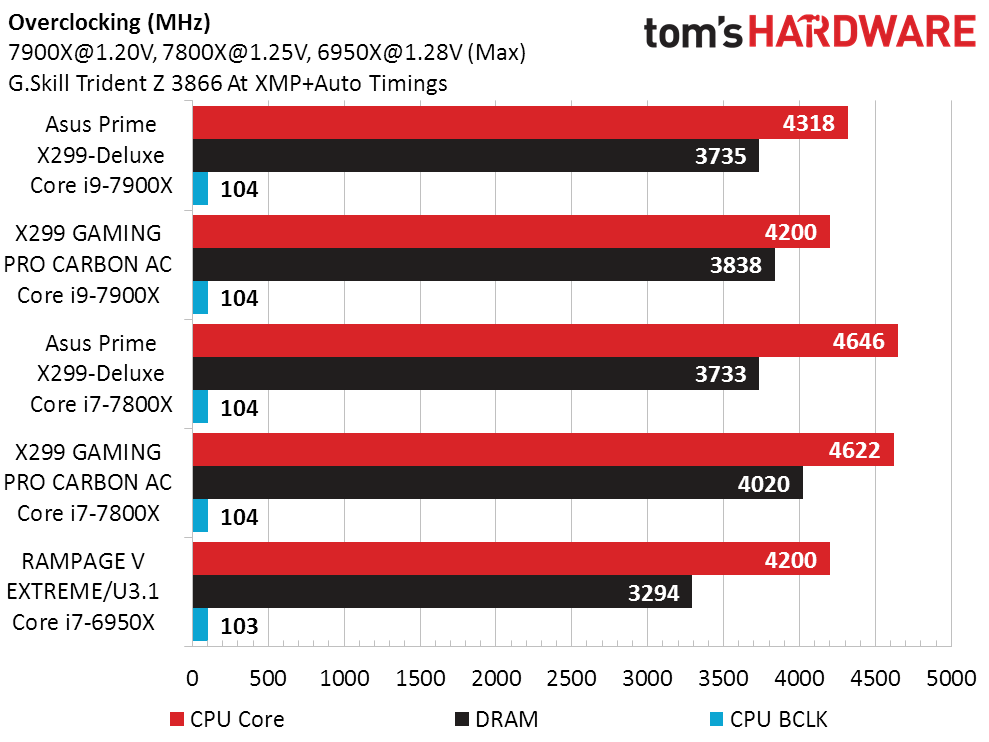
Surprisingly, the Prime X299-Deluxe switches positions in memory bandwidth against the X299 Gaming Pro Carbon AC, depending on which CPU is installed. We’ll likely find more consistency as these boards mature.
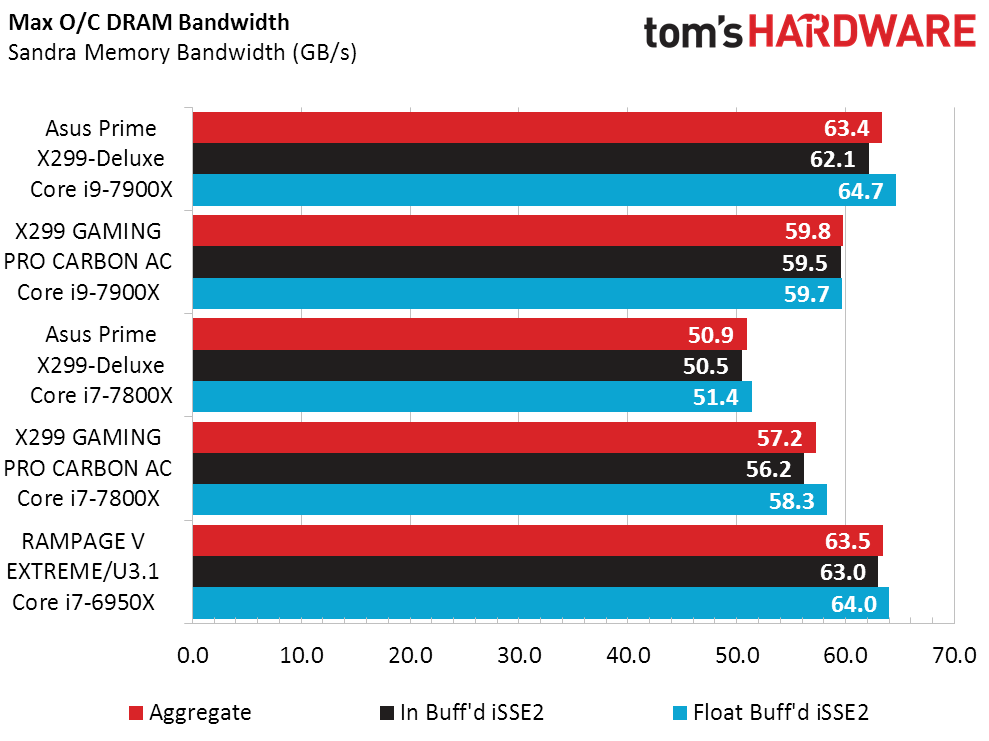
X299 Gaming Pro Carbon AC costs less for fewer features, and the result is more performance per dollar. Perhaps I should have used a cheaper X99 motherboard as the baseline, just to knock the newer boards down a value peg?
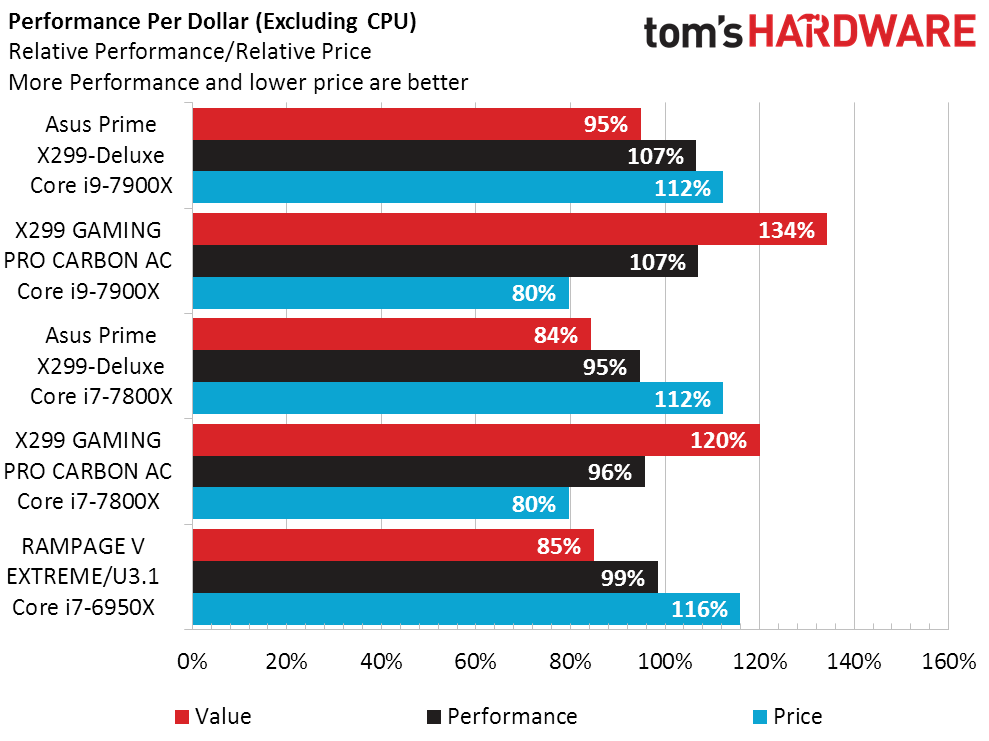
Since we included several processors in these benchmarks, a processor-based adjustment reveals a little more about why a buyer who had not yet made the leap to a 6950X might be glad he or she waited for the 7900X. Value increases by nearly half when moving from the 6950X to 7900X, and by half again when scaling down from the somewhat-expensive 7900X to the mid-priced 7800X.

The value charts tell us less about the boards, since the difference that included features adds is vast. MSI’s board doesn’t include a second network controller, or a Thunderbolt 3 add-in card with DisplayPort cable, or the additional components that make the Wi-Fi controller 802.11ad, or the Asus motherboard's OLED verbose status displays, or extra fan module. The lack of those features means the X299 Gaming Pro Carbon AC also costs $120 less than the Asus motherboard, which seems on par if you tally up those features.
Unfortunately, both boards are slightly too immature to issue an award today. On the other hand, if we had to spend our own money on an X299 motherboard today, the X299 Gaming Pro Carbon AC is the board half of us could afford.
MORE: Best Motherboards
MORE: How To Choose A Motherboard
MORE: All Motherboard Content
Stay On the Cutting Edge: Get the Tom's Hardware Newsletter
Get Tom's Hardware's best news and in-depth reviews, straight to your inbox.
-
JamesSneed Damn this board is pulling 77 more watts than the ASUS board in the Prime95 small FTT test. Things are certainly not sorted out yet on the x299 platform.Reply -
JamesSneed Why are none of the games the same games "you" tested with the 7900x review yesterday? I get not including Ryzen here but gosh could "you" at least make things standard so comparisons can be made to the 7900x review yesterday which had lots of data points for Ryzen with the latest fixes. Thomas, Paul and you should talk every now and then.Reply -
Crashman Reply
I believe we'll find that the problem is with the firmware we were using.19841125 said:Damn this board is pulling 77 more watts than the ASUS board in the Prime95 small FTT test. Things are certainly not sorted out yet on the x299 platform.
The CPU editor is a little fussier about showing certain performance details of the CPU. We picked the motherboard test suite during last fall's software update while leaning a little more heavily towards production volume (more reviews).19841143 said:Why are none of the games the same games "you" tested with the 7900x review yesterday? I get not including Ryzen here but gosh could "you" at least make things standard so comparisons can be made to the 7900x review yesterday which had lots of data points for Ryzen with the latest fixes. Thomas, Paul and you should talk every now and then.
-
mojolou I guess the power consumption difference between these 2 boards is because of different package TDP. If you check the package TDP with Intel XTU, I guess the Asus' package TDP is something like 17x W, while MSI 23x W. When running Prime95 Small FFTs, something limits 7900X from drawing expected power on Asus board.Reply -
Crashman Reply
You mean, working correctly stops it from drawing the expected power? I mean, Intel says 140W, the board, memory, and idle components draw around 60W in this test.19843656 said:I guess the power consumption difference between these 2 boards is because of different package TDP. If you check the package TDP with Intel XTU, I guess the Asus' package TDP is something like 17x W, while MSI 23x W. When running Prime95 Small FFTs, something limits 7900X from drawing expected power on Asus board.
-
JamesSneed Reply19842954 said:Only $ 2.000 for a new machine (i7-7800X)! For games!
I realize you were being sarcastic but If you have been around PC's 20+ years this is nothing. I recall paying over 2K for a PC that was pretty middle of the road non-gaming machine back around 1993-94. A high end PC back then would easily top 3K and that is not adjusting for inflation. Oh and memory was about $400 for 4MB(Not GB) sticks back around 1995.
The pricing now a days is pretty nice you can go really high end and stay under 3K.
Found this from 1993 add:
Dell was selling a top-of-the-line 486 with a 66MHz processor, eight megabytes of RAM and a 320-megabyte hard drive for $4,400. -
FrozenGerbil I placed an order for the MSI X299 Gaming Pro Carbon and the i9-7900X at Newegg, which also offered $50 off for the combo deal, along with a free Corsair AIO cooler included with the motherboard. After thoroughly researching all the available X299 motherboards currently available, MSI's X299 Pro Carbon hits the "sweet spot" for me and my intended use - 3D modeling and rendering, 4K video editing, and processing thousands of digital photos, including Adobe and HDR photo processing. I will be using this setup with a GTX 1050 Ti that I already have. My gaming rig stays the same - an MSI Z270 XPower Gaming Titanium, i7-7700K, and two MSI GTX 1080 Ti Gaming X GPUs. Yes, the Pro Carbon draws more power and runs warmer, but beats the more expensive Asus and Gigabyte X299 motherboards in numerous reviews that I have read.Reply
For anyone who thinks that $1000 is expensive for a 10-core 20-thread CPU, I grew up writing some BASIC programs on a Commodore 64. I worked part-time at IBM-Austin, helping IBM to build the IBM PC/XT and PC/AT while attending college at UT-Austin at the same time that Michael Dell was building and selling his PC clones from his UT-Austin dorm room. I used my very generous 50%-off IBM employee discount to buy a fully-loaded IBM PC/AT in 1985, which was the most powerful PC when it was initially released with its Intel 80286 processor and 640-KB of memory. The IBM prices for my fully-loaded PC/AT? $6400, including an enhanced graphics monitor and two dot matrix printers. I paid $3200 after IBM discount. The average smartphone now has more computing power than that $6400 PC that I bought in 1985.
For the AMD zealots who say that Threadripper will rip the threads off the i9-7900X, you need to know about the history of Intel vs. AMD since the 1980s. Intel is purposely not releasing the rest of their i9 CPUs sooner because they will wait to see what Threadripper has to offer and then adjust their own i9 CPUs to outflank and leap past Threadripper. Both Intel and Nvidia have been outflanking AMD, both on technical merits and marketing leverage, for decades now. When I was working at IBM during the mid-1980s, IBM hired some of the former AMD engineers and technicians when AMD broke their no-layoffs policy in 1984. And ever since then, AMD has had mass-layoffs every 3 to 5 years because they cannot sustain competition with either Intel or Nvidia. -
JamesSneed We shall see FrozenGerbil, Intel has some serious heat issues to overcome with the 12-18 core parts unless they pull the frequencies back a lot. Do I think Intel will hit back, sure and hard, what I'm not sure about if it will be Skylake-x like you suggested or a generation after. Speaking of IBM, Global Foundries bought out IBM's microprocessor division 2 years ago so AMD will be getting 7nm process node in 18 months to 2 years using IBM engineers and patents. That should be a game changer since AMD up until just now has always had a big process disadvantage versus Intel.Reply

